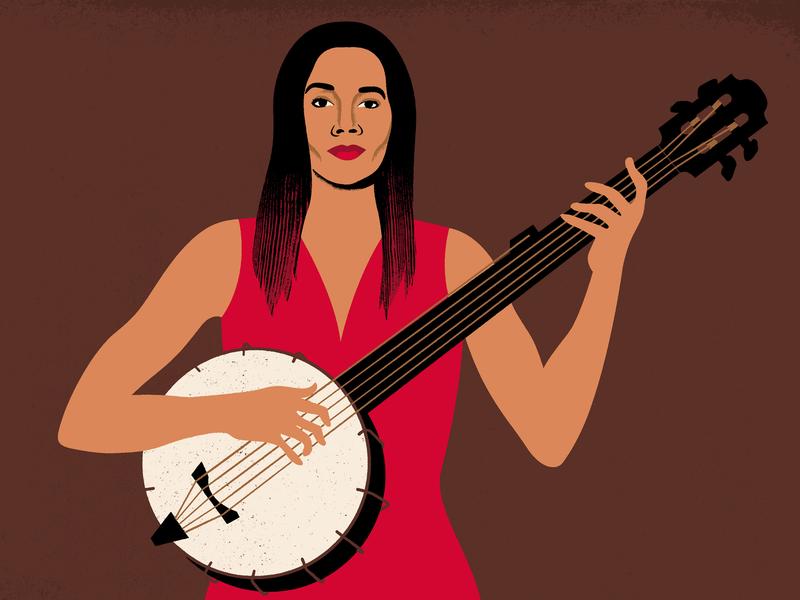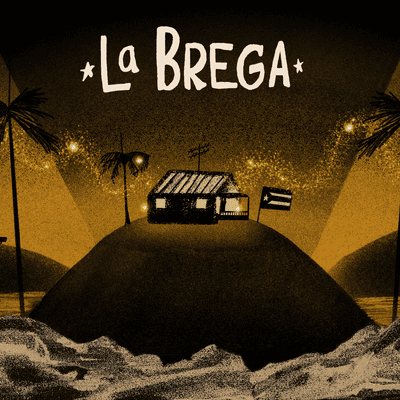Rhiannon Giddens, Americana’s Queen, Goes Global

David Remnick: This is The New Yorker Radio Hour. I'm David Remnick. Rhiannon Giddens has had one of the more unusual career paths of any musician I know of. She studied opera, training to be a soprano at one of the most prestigious music programs in the country. Almost by chance, she fell hard and deep into the study of American folk music. She became the frontwoman of a string band called the Carolina Chocolate Drops, focusing on reviving forgotten musical traditions of the Black diaspora. They received a Grammy award 10 years ago.
[Hit 'Em Up Style by Carolina Chocolate Drops starts playing]
While he was scheming, I was beamin' in the beamer, just beamin'
Can't believe that I caught my man cheating.
So I found another way to make him pay for it all.
So I went--
David: As a solo artist though, she's moved increasingly far afield. I spoke with her after her album, There Is no Other came out in 2019. She was exploring folk styles from the Middle East and Europe, as well as early America in collaboration with the musician, Francesco Turrisi. She's nominated for a Grammy for another album with Turrisi called They're Calling Me Home.
Rhiannon Giddens: Can I have your C?
[music]
Isn't, and the banjo tuned to the accordion the beginning of a joke of some sort?
David: When we spoke, they started off by playing Wayfaring Stranger, a traditional song dating to the 19th century.
[Wayfaring Stranger by Rhiannon Giddens playing]
I am a poor wayfaring stranger
Traveling through this world alone
There is no sickness, toil nor danger
In that fair land to which I go
I'm going home to meet my mother
I'm going home, no more to roam
I am just going over Jordan
I am just going over home
I know dark clouds will hover o'er me
I know my pathway's rough and steep
But golden fields lie out before me
Where weary eyes no more will weep
I'm going home to meet my father
I'm going home, no more to roam
I am just going over Jordan
I am just going over home
[music]
I'll soon be free from every trial
This form shall rest beneath the sod
I'll drop that cross of self-denial
And enter in that home with God
I'm going home to meet my Savior
I'm going home, no more to roam
I'm just going over Jordan
I'm just going over home
I'm just going over Jordan
I'm just going over home
[music]
David: Rhiannon and Francesco, that was magnificent. Thank you so much for coming.
Rhiannon: Thanks for having us.
David: Rhiannon, I have to tell you that I think it was six years ago already, six years ago-
Rhiannon: Oh, my gosh.
David: - that there was this amazing night at Town Hall in New York that was put on as a promotion and concert for Inside Llewyn Davis, which was about the folk scene of the late '50s and '60s. It was a pretty good lineup. [laughs]
Rhiannon: You're telling me. [chuckles]
David: Joan Baez, so many people. You got up and brought the house down, and brought the house to its feet. Tell me about that night, what you sang and what that was like, killing like that?
Rhiannon: It was a really interesting experience because when T Bone asked me to do it--
David: T Bone Burnett, who produced the album and all the music for the film.
Rhiannon: T Bone Burnett, yes. I hadn't done a lot of solo stuff at that point because I'd just really been doing the Chocolate Drops, and it was not with my band. It was all very instinctual. I just wanted to not screw up. I don't know. I was so shocked by the response to it the following days, the write-ups. I had no idea it was such a big deal. It was literally go sing the song and don't screw it up.
David: Did it change your career? Did it change your life in any way that night?
Rhiannon: It did, yes.
David: How so?
Rhiannon: My next two collaborations were with T Bone, and they totally came out of that night. My solo record, Tomorrow Is My Turn, I had no intention of going solo anytime soon. I was really focused on the Chocolate Drops, and I was very excited about it. Then, it was like, "When T Bone Burnett says, 'Let's do a solo record', you don't go, 'Can you come back in a couple of years?' You just go, 'Yes.'"
David: Your records are often categorized as something called Americana, which is a term that you hear a lot. It gets stuck on folk music, all the various kinds of music. Do you embrace it? Do you reject it? What does it mean to you?
Rhiannon: I have a complicated relationship with Americana as a term. I have a complicated relationship with genres. I hate them, number one.
David: You just want it to be called music.
Rhiannon: I just want it to be called music, or even American music is fine, acoustic music. Now, Americana, I understand what they're trying to do. Commercial country has gone down this certain road, and they're trying to create a space for the singer/songwriter for the story/song. I get all that. I still feel like you make a genre, you tend to narrow into it.
David: Now, you're on your third solo album, and you've got a new collaborator who's sitting here with us, Francesco Turrisi. Tell me about your musical relationship, and how this came to become an album.
Rhiannon: [chuckles] It was just one of those magical things. Do you want to say how--
Francesco Turrisi: Yes. I got in touch first with Rhiannon about four years ago because I knew about The Carolina Chocolate Drops, and I'd heard some of the music. I was doing a lot of research at the time in the early history of jazz, and I thought it was a very interesting take.
David: Scholarly research?
Francesco: I was lecturing the history of jazz. We're both musicians who have a lot of interest in research. I don't know if I would call myself a scholar, but we read a lot of books. Put it that way. I just thought it was a very interesting missing link that nobody talks about, the Black string band in the history of early jazz.
David: Tell us about that. What is the missing link, and describe what we're talking about?
Francesco: I don't know if I'm the right person to talk about this, but the way I saw it was just that-- Because I was actually teaching history of jazz in a BA course in Dublin, which is where I live. We both live in Ireland. Just reading all the classic literature on the earliest of jazz, everybody focus is very much on the brass bands and the importance of that in New Orleans in the development of early jazz. The string bands, I'd never really mentioned in that transition between ragtime and early jazz. They were obviously a big part of it all. Maybe you should say something about that because it's your corner.
David: What are we ignoring? What are we missing?
Rhiannon: Well, the string band, and the Black string band in particular, really is at the heart of so many, here we go, genres, again, the genres of American music. It was a widespread phenomenon that goes back to the time of slavery when Black people were seen as natural musicians, they were encouraged to pick up instruments and then play for white people's dances and frolics, and parties. You have the combination of native rhythms and modes from West Africa from all over where people were coming from, and instruments that were coming over like the banjo, which grew out of West African loop-type instruments. It's huge.
David: How much of this do we have recorded?
Rhiannon: Not any. That's the problem.
David: How are you excavating the music in a way?
Rhiannon: With dots,-
David: Does that give you enough?
Rhiannon: -with the sheet music.
David: That must give you a very wide berth on how to play.
Rhiannon: The thing is there's a lot of scholarship that's been done on these early banjo tutors. They were very, very clear on how to play this instrument and this--
David: They keep saying this instrument we have one on the floor here.
Rhiannon: Yes, sorry.
David: Can you describe what this is, because it's obviously not the thing that you'd see Earl Scruggs play.
Rhiannon: The banjo that I have is a replica of-- It's a composite of some banjos from the late 1850s. It's a wooden banjo. See, the early minstrel style banjos were all fretless. People are always surprised by this because it's fretless, and they were gut string. That's because they were that one step removed from the homemade gored instruments that Black folk would have been making on plantations or wherever. That was the banjo first. They were already playing these kind of instruments, which are wooden hoop, wooden fret board, fretless. It's just a deeper, more resonant round, warm sound.
David: Francesco, you're playing a drum that is called a--?
Francesco: Daf.
David: A Daf.
Francesco: It's a drum that comes from Iran. It's a large frame drum that has got a particularity. It's got little iron rings hanging. By shaking the drum, you hit the skin and they create a very washy type of sound.
David: Can you give it a little--
[drumming]
These many dozens of rings that are on the inside lip of the drum, that's what makes that honky sound.
Francesco: Yes. It's a drum that it's you find in Iran and in other countries in Central Asia used in folk music. It's also an instrument used by Sufi brotherhoods. They use it for trance dancing. This washy sound, very often you find in cultures related to trance.
David: What you're going to play is, I understand, is a ghost story, a song called Little Margaret. Can you tell me about that?
Rhiannon: That was actually one of the earliest things that we connected on this idea of the drum, the frame drum across the ocean, in Middle East, in North Africa, and the Mediterranean, being a drum that's supposed to be played with a singer because it's got a tone to it. We were looking for that connection. I thought, well, Appalachian ballots they also have that trance feel as well, and so it just worked so beautifully. Little Margaret, I learned from Sheila K Adams from western North Carolina. It goes all the way back to either some English ballad from centuries ago. That was the original.
David: We don't know who wrote it.
Rhiannon: No. It's old. It's really old. 14th century. It's old old, it goes back. This is an Appalachian version. It's basically the story of a young woman who was in love with a man. He goes out, starts seeing somebody else. Later that night, she appears to him at his bedside. He sees her and realizes that it's her that he wants, and so he goes to visit her. Then he finds out that she's died. In the song, the imagery is basically that her appearing in white means that she's a ghost, even though he doesn't realize that.
Then when he goes to her father's, and she's in a cold black coffin with her face turned toward the wall, her face turned toward the wall meant that she was a suicide. Then at the end, when he falls into her arms, that means he dies. These are all imagery that were used in lots of different ballads to denote these things without actually coming out and saying them.
David: Spooky stuff.
Rhiannon: Spooky stuff, yes.
David: I'd love to hear it.
Rhiannon: Well, let's do it.
[Little Margaret playing]
Little Margaret, sitting in her high hall chair
Combing back her long, yellow hair
Saw sweet William and his new-made bride
Riding up the road so near
She threw down her ivory comb
Threw back her long yellow hair
Said, "I'll go down and I'll bid him farewell
And I'll nevermore go there"
It was late in the night
They were fast asleep
Little Margaret appeared all dressed in white
Standing at their bed-feet
Saying, "How do you like your snow-white pillow?"
"How do you like your sheet?"
Saying, "How do you like that pretty fair maid
Who lays in your arms asleep?"
Very well do I like my snow-white pillow
Well do I like my sheet
Much better do I like that pretty fair maid
Who stands at my bed-feet
He called his serving-man to go
And saddled the dappled roan
And he rode for her father's house that night
Knocked on the door alone
Saying, "Is Little Margaret in her room
Or is she in the hall?"
"Little Margaret's in her coal-black coffin
With her face turned toward the wall"
Unfold, unfold those snow-white robes
Be they ever so fine
For I want to kiss those cold, cold lips
For I know they'll never kiss mine
Three times he kissed her cold, cold hand
Twice he kissed her cheek
But once he kissed her cold cold lips
Then he fell in her arms asleep
David: Amazing. How much of the song was given to you, and how much of it is yours in terms of its invention or melody?
Rhiannon: Is was originally an Appalachian ballad, like on a company. I'm singing it just like that. What I'm doing is when we first started playing it, instead of just going through the song with no pauses in between the lines, there were moments where the drum-- I would slow the action down a little bit, and then when it speeds up again. That that definitely came from me just kind of reacting to what he was playing.
[music]
David: Rhiannon Giddens, I spoke with her in 2019. Our conversation continues in a moment. This is The New Yorker Radio Hour.
[music]
This is The New Yorker Radio Hour. I'm David Remnick. I'm speaking today with the musician, Rhiannon Giddens who was just nominated for two Grammys, Best Folk Album, and Best American Roots Song. Giddens and I talked in 2019 when her album, There is No Other was just out, in collaboration with Francesco Turrisi. We'll continue now. Rhiannon you went to Oberlin, you studied, you had formal training there.
Rhiannon: Yes.
David: Doing a lot of opera. How did you become you? How did you create yourself and your sense of direction, and where you would go in music, coming out of a place like Oberlin where you had had this formal training?
Rhiannon: I--
David: Did you think you were going to be seeing less sonnambula, or being an opera singer.
Rhiannon: We all do, coming out of conservatory. We're going to be the next big soprano, you know.
David: What happened?
Rhiannon: I discovered folk music, and I discovered the banjo. I'm very interested in doing something that is A, of service, and B, that not everybody else is doing. I was like, gosh, there's a million sopranos in the world who can sing as good or much better than I can, who can do these things and want to devote their life to opera where I'm seeing this other thing and I'm like, "This is something I think I can make a difference in." It touches me and it speaks to me. For me, it goes to show that you have to find the thing that you were meant to do. You don't know what it is always, but if you follow the thing that's speaking to you, you just don't know where it's going to lead you.
David: I hate to pound on this notion of categories, but what you just sang is that classical music in a sense?
Rhiannon: No, but then what--
David: That's what I mean.
Rhiannon: What is classical music? We do, on the album, two arias. We do them in vernacular voice, and with improv the accompaniment. It's like they live in a different realm, and they touch people in a different way, but does it still mean that they're not an aria anymore? That's also the point of the record, is who cares what the--? This is not just smashing stuff together. That's important to mention. I mentioned our similar approaches because I think that's why our layers work, because we're layering things on top of each other and finding where the peaks peak, because there's all these similarities between all of these different things.
It leads us to what music is doing for us as humanity, because somebody was saying, "Our diversity is also our strength. You're saying that we're all the same." I'm like, "In our differences we're the same." That's the point, is that we express ourselves in different ways, but it's all coming back to these universal truths as humans. The more that we can reject that idea that you are over there and you sound different to me so that we're different people, and embrace that actually what I do in my culture and what you do in your culture is coming from the same heart, and therefore they should be able to work together. That's more of what we're trying to say.
David: How does that relate to the next song that I think you're going to do. You're going to have to help me with the pronunciation to get it exactly right, Pizzica di San Vito.
Francesco: That's pretty good.
David: It means?
Francesco: Pizzica is a type of dance from Puglia, which is a-
David: In southern Italy?
Francesco: -Apulian region. It's a type of tarantella, which is a very lively-- I'm sure you're familiar with the year of that. The particular thing about this music that a lot of people don't know about is that it was music to cure the bite of the spider.
[laughter]
No, this is very serious thing actually. The idea with the Pizzica is that you got bitten. They believed in the bite of the spider, tarantula, that's why it's called tarantella. You would fall into a state of depression, and the only way to get rid of this was to trance dance which could go on sometimes for weeks. The musicians would come to your house--
David: It's pre-antibiotics?
Francesco: Definitely pre-antibiotic. Mind you, this was the last time observed in its full power in the 1960s. 1960s, it was still happening in Puglia.
David: Incredible.
[banjo playing]
David: How is that tuned? How is it tuned?
Rhiannon: C, well right now it's in modal. I have three different tunings I use.
[banjo playing]
[Pizzica di San Vito music]
David: Whoa, amazing. Rhiannon, who do you think of as your audience for music like this? Or do you not think of it? Is it not worth thinking about?
Rhiannon: You just can't. You can't think about audiences. That's--
David: Who do you see in the seats?
Rhiannon: It depends on where we are. We haven't actually really started touring this yet. It depends on who knows about it. This is the push me, pull you of being a professional musician is that if they don't hear about it, they're not going to come. Part of my mission has been trying to get the music that I play to more of the Black community, for example, which is why people always ask me, "Why are they only white people at your shows?"
Number one, there aren't only white people at my shows. There are always people of color who come. It's just a very small percentage of the overall whole. The other thing is that the gatekeepers of Black culture are not interested in what I'm doing. This is a complaint I've heard from many, many people of color who do music that's not considered Black. Whether--
David: What does that mean? What is considered Black now, and who are the gatekeepers that we're talking about?
Rhiannon: Like hip-hop, R&B, blues. Blues, people know it's Black, and there's Black people who play it, but it's become--
David: It's a largely white audience.
Rhiannon: White audience and white players as well. Jazz is one of those, it's in that halfway house world. Then opera. There's been Black people singing opera and writing classical music forever. We're seen as interlopers, and so it's very hard. I've talked to other people who have the same thing. I was talking to Tavis Smiley. I was on his show because Freedom Highway, I started that tour at Sing Sing prison. It was the largest Black audience I've ever had. That just broke me in several pieces.
David: What was that like? Tell me about that concert.
Rhiannon: It was very intense to get a cultural response that I'm not used to because--
David: This is at Sing Sing Prison in Ossining, New York?
Rhiannon: Sing Sing Prison-- Yes.
David: Just north of the--
Rhiannon: Yes. Carnegie Hall does this amazing program going in. We worked with one of the prisoners on one of his songs about domestic violence. It was really intense. They were beautiful. You just--
David: It wasn't just a performance. You were there for a while?
Rhiannon: We did work--
David: A workshop.
Rhiannon: Yes, we were there the whole day. You just look out, they see a brown face, and you think about what does that mean for when you talk about the incarceration of Black men and men of color. How broken the system is. Then from a purely performance point of view, I was just like, "The way that they responded to the music was different than when I have majority white."
David: How so?
Rhiannon: It's hard to explain. Just the energy that was given back and I didn't know the personal stories of any of them. Didn't want to know, because it's just like that wasn't the purpose of the visit.
David: What did you play for them?
Rhiannon: We played a full concert. I brought my full band. We played a lot of stuff from Freedom Highway. I feel very strongly. I'm starting to work with my nephew who's a 21-year-old rapper who plays the banjo. I taught--
David: [chuckles] That's an unusual combination.
Rhiannon: It is an unusual combination. He's a heavy rapper. He knows hip-hop, he knows that world. This is the way he chooses to express himself with rap words.
David: You're going to record with him?
Rhiannon: Yes. I'm going to record.
David: What's his name?
Rhiannon: His name is Justin Harrington. Demeanor is his handle. It's just like when you start crossing over into that generation and he sees, he's like, "Man, when I'm playing this stuff for my friends they're like, 'What is that? That's amazing.'" I'm like, "Exactly." It's like when people are exposed to this stuff, they're like, "That's so cool," but getting there is the hurdle.
David: Rhiannon and Francesco, thank you so much for coming.
Rhiannon: Thanks for having us.
[music]
David: Rhiannon Giddens and her collaborator, Francesco Turrisi. I spoke with them in 2019. They're nominated for two Grammys for the album They're calling me home.
[music]
Copyright © 2024 New York Public Radio. All rights reserved. Visit our website terms of use at www.wnyc.org for further information.
New York Public Radio transcripts are created on a rush deadline, often by contractors. This text may not be in its final form and may be updated or revised in the future. Accuracy and availability may vary. The authoritative record of New York Public Radio’s programming is the audio record.





